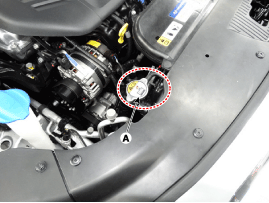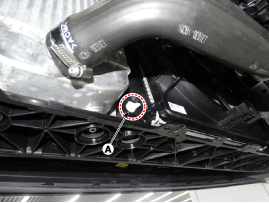Hyundai Sonata LF: Cooling System / Coolant Repair procedures
Hyundai Sonata LF 2014-2019 Service Manual / Engine Mechanical System / Cooling System / Coolant Repair procedures
| Replacement And Air Bleeding |
Never remove the radiator cap when the engine is hot. Serious
scalding could be caused by hot fluid under high pressure escaping from
the radiator. |
When pouring engine coolant, be sure to shut the relay box
lid and not to let coolant spill on the electrical parts or the paint.
If any coolant spills, rinse it off immediately. |
| 1. |
Make sure the engine and radiator are cool to the touch. |
| 2. |
Remove the radiator cap (A).
|
| 3. |
Remove the under cover. |
| 4. |
Loosen the drain plug (A), and drain the coolant.
|
| 5. |
Tighten the radiator drain plug securely. |
| 6. |
After draining engine coolant in the reservoir tank, clean the tank. |
| 7. |
Fill the radiator with water through the radiator cap and tighten the cap.
|
| 8. |
Start the engine and allow to come to normal operating
temperature. Wait for the cooling fans to turn on several times.
Accelerate the engine to aid in purging trapped air. Shut engine off. |
| 9. |
Wait until the engine is cool. |
| 10. |
Repeat steps 1 to 8 until the drained water runs clear. |
| 11. |
Fill fluid mixture with coolant and water (55~60%) (except
for North America, Europe and China : 45~50%) slowly through the
radiator cap.
Push the upper/lower hoses of the radiator so as bleed air easily.
|
| 12. |
Start the engine and run until coolant circulates.
When the cooling fan operates and coolant circulates, refill coolant through the radiator cap. |
| 13. |
Repeat step.11 until the cooling fan 3 ~ 5times and bleed air sufficiently out of the cooling system. |
| 14. |
Install the radiator cap and fill the reservoir tank to the "MAX" (or "F") line with coolant. |
| 15. |
Run the vehicle under idle until the cooling fan operates 2 ~ 3 times. |
| 16. |
Stop the engine and wait coolant gets cool. |
| 17. |
Repeat 10 to 15 until the coolant level doesn't fall any more, bleed air out of the cooling system.
|
Other information:
Hyundai Sonata LF 2014-2019 Service Manual: Crash Pad Lower Panel Repair procedures
Replacement • Put on gloves to protect your hands. • When prying with a flat-tip screwdriver or use a prying trim tool, wrap it with protective tape, and apply protective tape around the related parts, to prevent damage...
Hyundai Sonata LF 2014-2019 Service Manual: Rear Door Window Glass Components and Components Location
C..
Categories
- Manuals Home
- Hyundai Sonata Owners Manual
- Hyundai Sonata Service Manual
- General Information
- Engine Control / Fuel System
- Brake System
- New on site
- Most important about car
Copyright © 2026 www.hsonatalf.org






